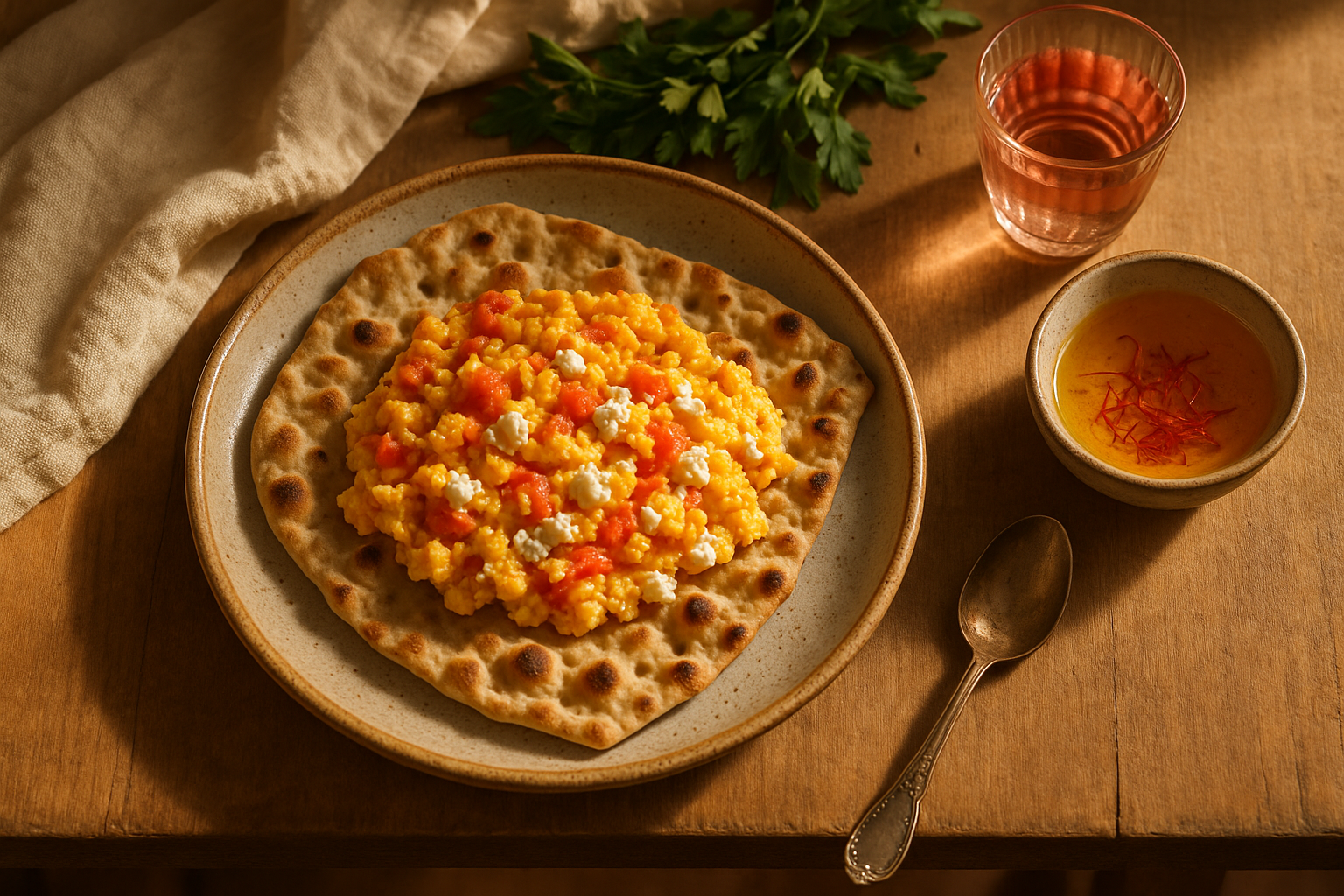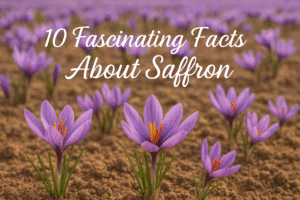Have you ever looked at your breakfast plate and thought, “Something’s missing”? That something might just be saffron, the world’s most precious spice. At Zarafron, we believe that everyday wellness begins with what you put on your plate, and there’s no more luxurious way to start your day than with saffron-infused scrambled eggs.
Saffron, derived from the delicate crimson stigmas of the Crocus sativus flower, has been treasured for millennia across cultures for its distinct flavor, golden hue, and remarkable health benefits. Each strand contains over 150 volatile compounds that contribute to its complex taste profile. It’s simultaneously floral, honey-like, and slightly bitter with earthy undertones.
Today, we’re diving into the art of creating the perfect saffron scrambled eggs. This is a simple yet transformative dish that elevates a humble breakfast staple into something truly special. In other words, this isn’t just a recipe; it’s an introduction to incorporating this ancient spice into your modern wellness routine.
Why Saffron Belongs in Your Kitchen (and Your Life)
Before we crack our first egg, let’s take a moment to understand why saffron deserves a permanent spot in your spice cabinet. Beyond its culinary applications, saffron has been studied extensively for its wellness properties. For example:
- Mood Enhancement: Research suggests saffron can help balance mood and support emotional wellbeing, which is perfect for starting your day on a positive note.
- Antioxidant Powerhouse: Saffron contains crocin, crocetin, and safranal, all potent antioxidants that help combat oxidative stress.
- Digestive Support: Traditionally, people have used saffron to aid digestion and soothe the stomach, making it an ideal breakfast companion.
- Anti-Inflammatory Properties: Saffron contains compounds that may help reduce inflammation throughout the body.
By incorporating saffron into your morning eggs, you’re not just creating a delicious meal. Instead, you’re embracing an ancient wellness tradition with modern scientific backing.
Selecting Your Saffron: Quality Matters
The secret to exceptional saffron dishes begins with selecting high-quality saffron. Here’s what to look for:
- Color: Deep red threads with orange tips indicate premium quality.
- Aroma: Fresh saffron should have a sweet, honey-like fragrance.
- Form: Choose whole threads over powder whenever possible for freshness and to avoid adulteration.
- Certification: Look for ISO 3632 certification, which indicates verified quality standards.
At Zarafron, we emphasize the importance of authentic spices that deliver both flavor and wellness benefits. As a result, the difference between premium saffron and lower-quality alternatives is immediately noticeable in both taste and therapeutic effect.
The Art of Blooming Saffron
One of the most crucial steps in working with saffron is proper “blooming.” This is the process of extracting flavor, color, and beneficial compounds from the threads. Notably, this step cannot be rushed and sets the foundation for our scrambled eggs.
The Blooming Process:
- Take a small pinch of saffron threads (about 15 to 20 strands or 1/4 teaspoon).
- Gently crush the threads between your fingers or with a mortar and pestle.
- Add 2 tablespoons of warm (not boiling) water.
- Let steep for at least 5 minutes, ideally 15 to 20 minutes for maximum extraction.
- Watch as the water transforms into a golden-amber liquid, releasing saffron’s aroma.
This blooming process is essential for unlocking saffron’s full potential. The warm water helps release the water-soluble compounds, including crocin (responsible for color) and picrocrocin (flavor), while the fat-soluble safranal (aroma) begins to perfume the air.
The Ultimate Saffron Scrambled Eggs Recipe
Now, let’s bring together this ancient spice with the humble egg to create something truly magnificent.
Ingredients (serves 2):
- 6 large fresh eggs
- 1 generous pinch saffron threads (approximately 1/4 teaspoon)
- 2 tablespoons warm water (for blooming saffron)
- 2 tablespoons unsalted butter
- 1/3 cup crumbled feta cheese
- 1/4 cup diced ripe tomatoes (seeds removed)
- 1 tablespoon freshly chopped chives
- Salt and freshly ground black pepper to taste
- Flatbread for serving
Method:
- Bloom the saffron: Follow the blooming process described above, allowing the saffron to steep in warm water for at least 5 minutes until the water turns a deep golden color.
- Prepare your ingredients: While the saffron blooms, dice your tomatoes and crumble the feta cheese. Having everything ready is essential for perfect scrambled eggs.
- Whisk the eggs: In a medium bowl, crack the eggs and whisk them until just combined. You want to incorporate the whites and yolks without introducing too much air. Next, add the bloomed saffron liquid to the eggs and whisk gently to combine. The mixture should take on a beautiful golden hue.
- Heat your pan: Use a non-stick skillet or a well-seasoned cast iron pan. Heat it over medium-low heat. Temperature control is crucial for creamy eggs.
- Add the butter: Once the pan is warm, add the butter and allow it to melt completely, swirling to coat the pan. The butter should foam slightly but not brown.
- Cook with patience: Pour in the saffron-egg mixture. Let it sit undisturbed for about 30 seconds, then begin to gently fold the eggs with a silicone spatula, moving from the edges toward the center.
- Mind the texture: Continue folding the eggs gently, taking the pan off the heat occasionally to ensure slow, even cooking. We’re aiming for soft, tender curds, not dry, overcooked eggs.
- Add the mix-ins: When the eggs are about 75 percent set but still look slightly wet, fold in the diced tomatoes and most of the feta cheese (reserve some for garnish).
- Finish and serve: Remove from heat while the eggs still look slightly underdone. They’ll continue cooking from residual heat. Immediately transfer to warmed plates, garnish with the remaining feta, fresh chives, and a few turns of black pepper.
- The perfect bite: Serve alongside warm flatbread. Tear off pieces of bread and use them to scoop up the eggs.
The Science Behind Perfect Scrambled Eggs
What makes these scrambled eggs special isn’t just the saffron. It’s the technique. Here’s why our method works:
- Low and slow cooking: Proteins in eggs denature (unfold) and coagulate (bond together) when heated. Cooking slowly at a lower temperature allows this process to happen gently, resulting in tender curds rather than tough, rubbery eggs.
- Removing from heat: Taking the pan off the heat periodically prevents overheating and gives you more control over the cooking process.
- Adding salt at the end: Salt draws out moisture through osmosis. Adding it too early can make eggs watery and affect the color development of the saffron.
- Residual cooking: Proteins continue to set even after the pan is removed from heat. Stopping the cooking process when eggs look slightly underdone ensures they’ll be perfectly creamy when served.
Variations to Explore
Once you’ve mastered the basic recipe, consider these variations to keep your saffron egg routine fresh and exciting:
- Mediterranean Morning: Add 1 tablespoon of chopped Kalamata olives, sprinkle with za’atar seasoning, and serve with a side of Greek yogurt.
- Persian Inspiration: Fold in 2 teaspoons of finely chopped preserved lemon, add 1 tablespoon of chopped fresh dill, and garnish with pomegranate seeds for a burst of color and flavor.
- Luxury Upgrade: Add 1 tablespoon of crème fraîche just before the eggs are done, top with a small amount of high-quality caviar, and serve with thinly sliced smoked salmon.
Remember, saffron pairs beautifully with dairy, citrus, and aromatic herbs. Therefore, feel free to experiment with your favorite combinations.
From Our Kitchen to Yours
The beauty of saffron lies in its ability to transform the ordinary into the extraordinary. As a result, a simple plate of scrambled eggs becomes a golden experience for the senses. It’s visually stunning, aromatically complex, and deliciously satisfying.
We’d love to hear about your experience with this recipe! Share your saffron cooking adventures with us using #SaffronRitual and #ZarafronWellness, and discover more ways to incorporate this ancient spice into your modern wellness routine.
Here’s to golden mornings and the simple luxuries that make life delicious!




